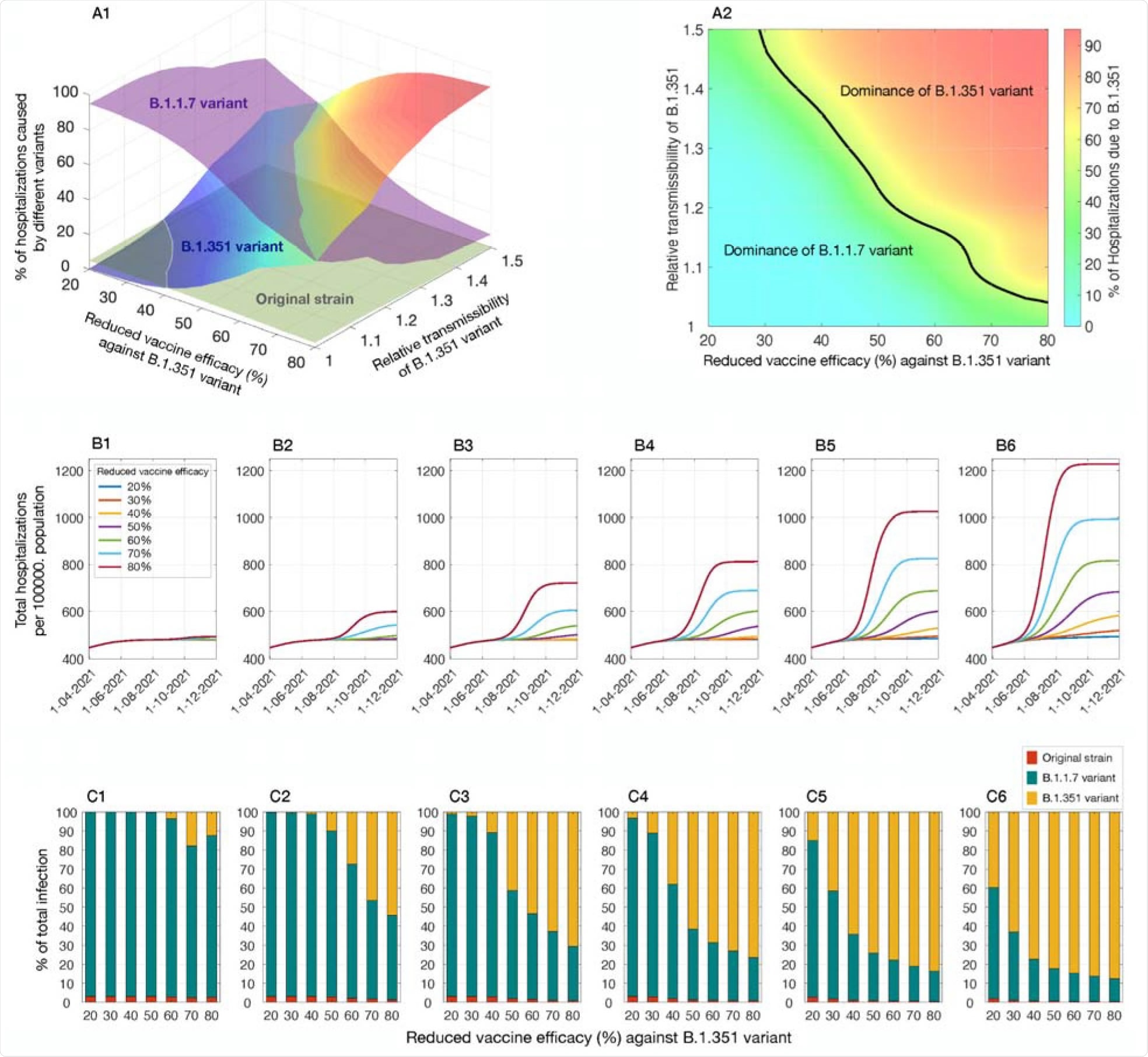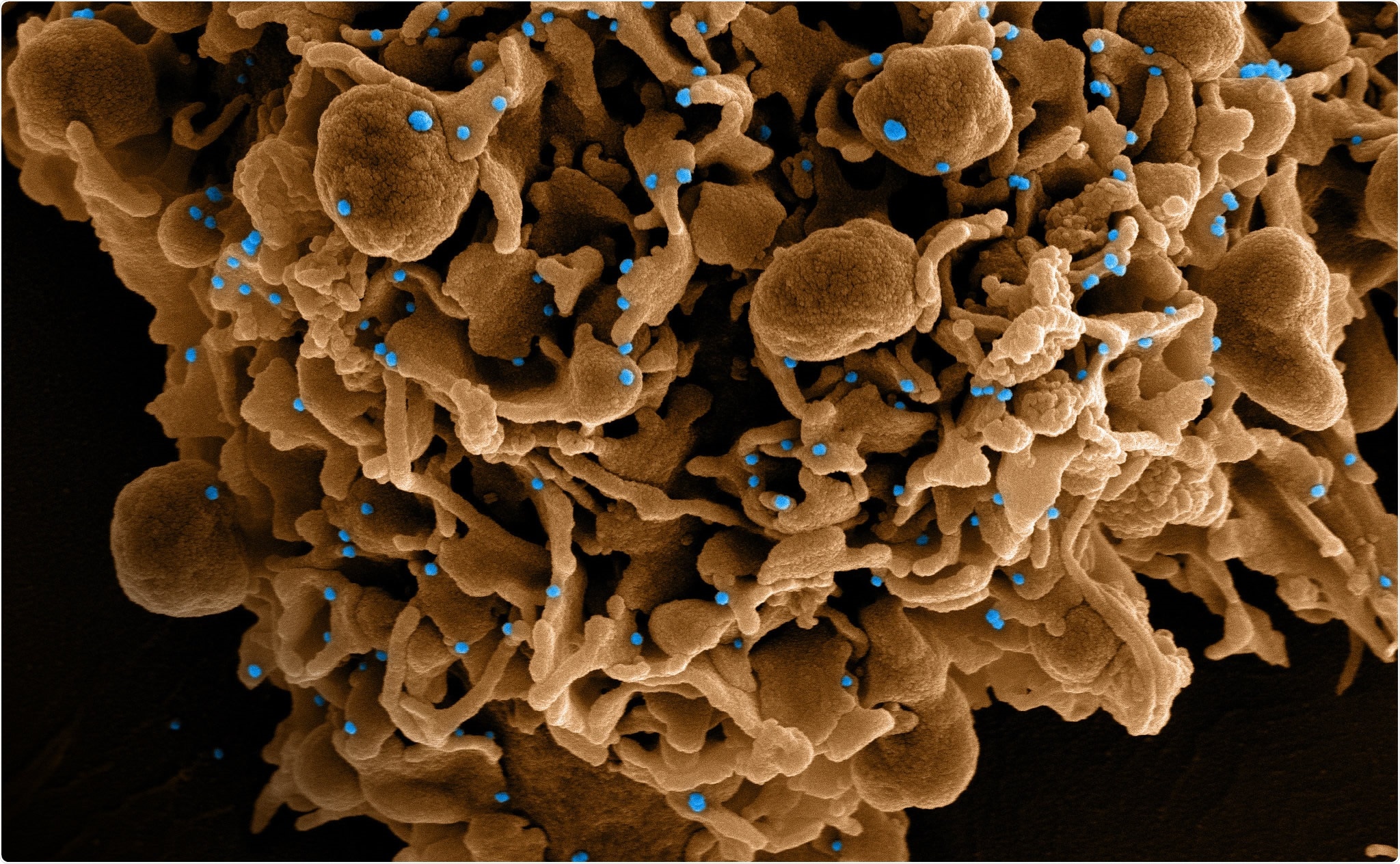Researchers in the United States and Canada have conducted a study showing that the South African variant of severe acute respiratory syndrome coronavirus 2 (SARS-CoV-2) – the agent that causes coronavirus disease 2019 (COVID-19) – is unlikely to become the dominant strain in the US.
Using a dynamic transmission model, the researchers showed that dominance of the B.1.351 lineage is unlikely, even once fully vaccinated individuals return to their pre-pandemic behavior.
However, if the variant acquires a sufficiently high selection advantage through increased transmission and immune escape, it could become dominant as soon as July 2021, leading to a resurgence in infections and hospital admissions.
“Our study underscores the urgency for continued rollout of the current generation of vaccines despite the emergence of immune escape variants,” writes the team from Yale School of Public Health in New Haven, Connecticut, York University in Toronto, Ontario and University of Maryland School of Medicine in Baltimore.
Adherence to non-pharmaceutical mitigation measures should also be continued until viral circulation has been driven to low levels, adds Alison Galvani and colleagues.
A pre-print version of the research paper is available on the medRxiv* server, while the article undergoes peer review.
Emerging variants pose a threat to vaccination efficacy
As of May 13th, 2021, more than 265 million doses of COVID-19 vaccines had been administered in the US and 35.8% of the population had been fully vaccinated.
While the number of daily cases has dropped significantly since the pandemic peaked, new variants with a selection advantage due to increased transmissibility and immune escape are becoming more prevalent.
The B1.1.7 lineage that first emerged in the UK is now the predominant variant in the US and other variants, including B.1.351 (South Africa), P.1 (Brazil), and B.1427/1429 (California) are also on the rise.
The three vaccines (from Pfizer-BioNTech, Moderna, and Johnson & Johnson) that are being rolled out in the US have all shown high efficacy in preventing symptomatic COVID-19 caused by the original Wuhan-1 strain that was identified early on in the pandemic.
However, studies have recently shown that the B.1.351 variant exhibits partial evasion of the neutralizing antibodies generated following vaccination.
The effect of this reduced neutralizing activity on the protection offered by vaccines has yet to be determined.
Although the prevalence of B.1.351 in the US is currently relatively low – at around 0.7% – the growing evidence of immune evasion and vaccine escape has led to concerns that the administration of first-generation vaccines will not be enough to end the pandemic.
Meanwhile, the interim guidelines from the US Centers for Disease Control and Prevention (CDC) have allowed fully vaccinated individuals to return to certain pre-pandemic activities starting from April 3rd.
However, “premature relaxation of social distancing measures could enhance the selective advantage for immune escape variants, hampering the ability of vaccination to control the pandemic,” says Galvani and colleagues.
What did the researchers do?
The researchers used a dynamic transmission model to assess whether vaccine and immunity-mediated selection pressures could help drive the dominance of B.1.351 in the presence of the original Wuhan-1 strain and the B.1.1.7 variant under the CDC’s interim guidelines.
A two-dose vaccination campaign of the Moderna vaccine was implemented, with immunization starting on December 12th, 2020. The transmissibility of the original strain was calibrated by fitting the model to the number of reported cases in the US per 100,000 population from October 1st, 2020 to April 16th, 2021.
The B.1.1.7 variant was introduced on December 1st, 2020, with a 50% higher transmissibility than the original strain, and the B.1.351 variant was introduced on January 28th, 2021.
Since data available on the selective advantage of B.1.135 are limited, the researchers varied its transmissibility from equal to that of the original strain to 50% more transmissible. They also reduced vaccine efficacy by between 20 and 80%.
The model projected the incidence of cases and hospitalizations caused by the variants and the original strain between April 3rd and December 31st, 2021
What did the study find?
The analysis predicted that the number of infections and hospitalizations caused by B.1.135 would remain low unless its selection advantage started to exceed a threshold curve.
For example, with similar transmissibility to the original strain, B.1.135 would account for less than 28% of hospitalizations, even if vaccine efficacy were reduced by as much as 80%.
However, if B.1.135 were 20% more transmissible than the original strain and vaccine efficacy against it were reduced by 60%, the peak daily incidence of infection would be 19.2 per 100,000 population, with a total of 96 hospitalizations per 100,000 population over the nine-month evaluation period. This corresponds to 316,535 hospitalizations across the entire US.
If the variant were 50% more transmissible and vaccine efficacy fell by 60%, the peak daily incidence would be 93 cases per 100,000 population, causing a total of 1,228,763 hospitalizations over the nine months.

What are the implications of the findings?
The team says the findings indicate that the B.1.351 variant would require a relatively high selection advantage for it to evade naturally-acquired or vaccine-induced immunity and become dominant.
While the evidence is suggesting that convalescent and vaccine sera exhibit reduced protection against the B.1.351 variant, its selection advantage may not be high enough to compete with the B.1.1.7 variant.
“However, an improved selection advantage of B.1.351 arising from a combination of increased transmission and immune escape could drive this variant to dominance as early as July 2021 and fuel a resurgence of cases and hospitalizations,” warns Galvani and colleagues.
The researchers advise that while vaccine uptake increases, adherence to non-pharmaceutical mitigation measures should continue until viral circulation is driven to low levels.
“Our results further show that despite the evidence of immune escape, the rollout of the current generation of vaccines remains an effective strategy to combat the pandemic,” they conclude.
*Important Notice
medRxiv publishes preliminary scientific reports that are not peer-reviewed and, therefore, should not be regarded as conclusive, guide clinical practice/health-related behavior, or treated as established information.
https://news.google.com/__i/rss/rd/articles/CBMigAFodHRwczovL3d3dy5uZXdzLW1lZGljYWwubmV0L25ld3MvMjAyMTA1MTMvRG9taW5hbmNlLW9mLVNvdXRoLUFmcmljYW4tU0FSUy1Db1YtMi12YXJpYW50LWluLXRoZS1VUy1pcy11bmxpa2VseS1idXQtcG9zc2libGUuYXNweNIBhAFodHRwczovL3d3dy5uZXdzLW1lZGljYWwubmV0L2FtcC9uZXdzLzIwMjEwNTEzL0RvbWluYW5jZS1vZi1Tb3V0aC1BZnJpY2FuLVNBUlMtQ29WLTItdmFyaWFudC1pbi10aGUtVVMtaXMtdW5saWtlbHktYnV0LXBvc3NpYmxlLmFzcHg?oc=5
2021-05-14 02:25:00Z
CAIiEOQNEWsenBpV0sTR2QOZVOAqMwgEKioIACIQZdRflS9INK7zM5FkBi3R3CoUCAoiEGXUX5UvSDSu8zORZAYt0dwwr47MBg
Bagikan Berita Ini















0 Response to "Dominance of South African SARS-CoV-2 variant in the US is unlikely but possible - News-Medical.Net"
Post a Comment